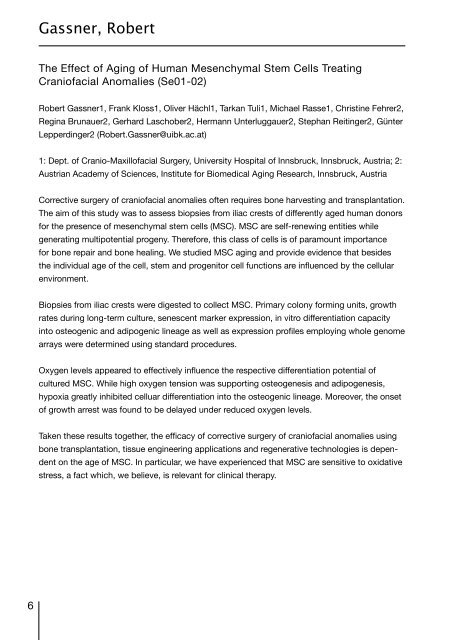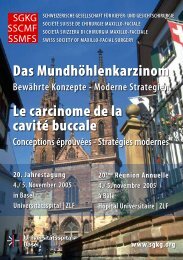ÖGMKG - und Gesichtschirurgie
ÖGMKG - und Gesichtschirurgie
ÖGMKG - und Gesichtschirurgie
Erfolgreiche ePaper selbst erstellen
Machen Sie aus Ihren PDF Publikationen ein blätterbares Flipbook mit unserer einzigartigen Google optimierten e-Paper Software.
Gassner, Robert<br />
The Effect of Aging of Human Mesenchymal Stem Cells Treating<br />
Craniofacial Anomalies (Se01-02)<br />
Robert Gassner1, Frank Kloss1, Oliver Hächl1, Tarkan Tuli1, Michael Rasse1, Christine Fehrer2,<br />
Regina Brunauer2, Gerhard Laschober2, Hermann Unterluggauer2, Stephan Reitinger2, Günter<br />
Lepperdinger2 (Robert.Gassner@uibk.ac.at)<br />
1: Dept. of Cranio-Maxillofacial Surgery, University Hospital of Innsbruck, Innsbruck, Austria; 2:<br />
Austrian Academy of Sciences, Institute for Biomedical Aging Research, Innsbruck, Austria<br />
Corrective surgery of craniofacial anomalies often requires bone harvesting and transplantation.<br />
The aim of this study was to assess biopsies from iliac crests of differently aged human donors<br />
for the presence of mesenchymal stem cells (MSC). MSC are self-renewing entities while<br />
generating multipotential progeny. Therefore, this class of cells is of paramount importance<br />
for bone repair and bone healing. We studied MSC aging and provide evidence that besides<br />
the individual age of the cell, stem and progenitor cell functions are influenced by the cellular<br />
environment.<br />
Biopsies from iliac crests were digested to collect MSC. Primary colony forming units, growth<br />
rates during long-term culture, senescent marker expression, in vitro differentiation capacity<br />
into osteogenic and adipogenic lineage as well as expression profiles employing whole genome<br />
arrays were determined using standard procedures.<br />
Oxygen levels appeared to effectively influence the respective differentiation potential of<br />
cultured MSC. While high oxygen tension was supporting osteogenesis and adipogenesis,<br />
hypoxia greatly inhibited celluar differentiation into the osteogenic lineage. Moreover, the onset<br />
of growth arrest was fo<strong>und</strong> to be delayed <strong>und</strong>er reduced oxygen levels.<br />
Taken these results together, the efficacy of corrective surgery of craniofacial anomalies using<br />
bone transplantation, tissue engineering applications and regenerative technologies is depen-<br />
dent on the age of MSC. In particular, we have experienced that MSC are sensitive to oxidative<br />
stress, a fact which, we believe, is relevant for clinical therapy.<br />
Gassner, Robert<br />
Mechanical signalling affecting corrective surgery of craniofacial<br />
anomalies (Se01-03)<br />
Robert Gassner1, James Deschner2, Nick Piesco3, Sudha Agarwal4 (Robert.Gassner@uibk.<br />
6 7<br />
ac.at)<br />
1: Department of Cranio-Maxillofacial Surgery, Medical University of Innsbruck; 2:Dental<br />
School, University of Bonn; 3:Department of Oral Histology, University of Pittsburgh; 4:Division<br />
of Oral Biology, Ohio State University<br />
During wo<strong>und</strong> healing following corrective surgery of craniofacial anomalies mechanical signals<br />
play an important role. Such signals are observed at the interface of bone and teeth, where<br />
osteoblast-like periodontal ligament (PDL) cells constantly take part in bone formation and<br />
resorption in response to applied mechanical forces. Signals generated by tensile strain of low<br />
magnitude (TENS-L) are antiinflammatory, whereas tensile strain of high magnitude (TENS-H)<br />
is proinflammatory and catabolic. In this study, we examined the mechanisms of intracellular<br />
actions of the antiinflammatory and proinflammatory signals generated by TENS of various<br />
magnitudes. We show that both low and high magnitudes of mechanical strain exploit nuclear<br />
factor (NF)-kappaB as a common pathway for transcriptional inhibition/activation of proin-<br />
flammatory genes and catabolic processes. TENS-L is a potent inhibitor of interleukin (IL)-1<br />
beta-induced I-kappaBbeta degradation and prevents dissociation of NF-kB from cytoplasmic<br />
complexes and thus its nuclear translocation. This leads to sustained suppression of IL-1beta-<br />
induced NF-kappaB transcriptional regulation of proinflammatory genes. In contrast, TENS-H is<br />
a proinflammatory signal that induces I-kappaBbeta degradation, nuclear translocation of NF-<br />
kappaB, and transcriptional activation of proinflammatory genes. In conclusion these findings<br />
describe actions of applied tensile forces in osteoblast-like cells and have critical implications<br />
in particular for surgical procedures of craniofacial anomalies.



